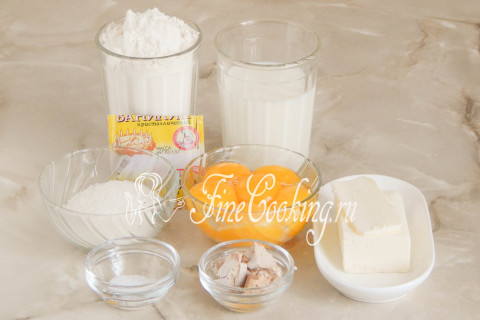Step 1
To prepare a lace cake, you will need the wheat flour of the highest grade, milk, butter (at least 82% fat), egg yolks, granulated sugar, yeast, salt and vanillin (optional). My yeast is pressed (fresh), but if you wish, you can replace them with dry or fast -acting (take 3 times less, that is, 3.5 grams — this is 1 teaspoon with a very tiny tree).
Step 2
We will prepare the yeast dough for these air and magnificent Easter Easter cakes on the dough, about which I have already written many times. Pour 150 milliliters into a bowl of slightly warm milk and crumble fresh yeast in it. We mix everything thoroughly so that the yeast dissolves, after which we sift there 150 grams of wheat flour of the highest grade.
Step 3
Mix everything well so that there are no lumps. We tighten the bowl with a dietary film or a plastic bag and leave in a warm (28-30 degrees) place for 2-4 hours. The time of fermentation of dough, as well as the yeast dough as a whole, is a relative concept and depends on the activity of yeast and the temperature in the room.
Step 4
When you see that the Opara has increased several times, probably it is already ready for further work.
Step 5
You are probably tired of reading about dough about dough with my recipes for homemade baking, but I will repeat anyway. First of all, mature downs increases very well in volume. In addition, if you pick it up with a spoon or fork, you will notice that the acute is pierced through and through the air bubbles. But these are not all indicators of her readiness — it is recommended to enter the dough into the dough when it has already grown in volume and has already begun to sag a little (especially in the center). I deliberately write this in capital letters, as it is really important. I did not write pastries in recipes before, as she did not suspect that many may simply not know this nuance. In other words, the yeast had already managed to eat everything tasty in the composition of dough and was hungry, so it is time for them to eat again. And then we introduce them into the dough. I hope I clearly explained.
Step 6
Now in a container where the yeast dough for lace cakes will roam, we put 7 egg yolks. Add there 50 grams of sugar, a quarter of a teaspoon of salt and a pinch of vanillin.
Step 7
Beat everything with a whisk (with your hands or with the help of a mixer) until the yolks with sugar are whitewashed and turn into a magnificent, homogeneous mass, which in consistency resembles a delicious cream or sour cream of 20% fat content. Sugar must completely dissolve.
Step 8
Put the dug into the yolks and mix everything.
Step 9
Add 150 grams of sifted flour of the highest grade.
Step 10
I must say right away that it is quite difficult and for a long time to knead such yeast dough with your hands, so if possible use a mixer or a combine with a barrel nozzle. Now we mix all the ingredients to achieve uniformity and relative smoothness.
Step 11
When the dough becomes homogeneous, we begin to gradually introduce soft butter into it (take it out of the refrigerator for an hour and a half for an hour and a half). Gradually — this means literally a tablespoon. Only when the portion of the oil completely intervenes in the dough, add the next.
Step 12
When all the oil is added, the dough needs to be intensively (I turn on 3 speed) knead at least another 10 minutes. If there is no mixer, the kneading must be made according to French technology (stretching-worship) for about 15 minutes. As a result of the works (yours or electric shifters), a very soft, sticky, mobile, stretching dough should be obtained. It is very wet and almost does not hold shape, lazily slides off the hook. At the same time, it is brilliant and smooth. Do not be scared and in no case add flour — it will not turn out that airiness and weightlessness in ready -made cakes.
Step 13
Now take another bowl, lubricate it a little with vegetable oil (in the ingredients I did not indicate it, but literally a teaspoon) and transfer the dough into it. Hands, too, or moisten with water or grease with oil, since the dough is more than sticky. Now it’s time for us to relax, and give the dough the time of fermentation in the heat for 2-3 hours. Where is it better to wander the test and what does a warm place mean? There are several options. First of all, in the oven with a light bulb turned on (it turns out about 28-30 degrees — the temperature ideal for fermentation of yeast dough). Then we tighten the bowl with the dough with cling film or cover with a towel made of natural fabric (flax is best suited) so that the surface does not be swollen and not covered with a crust. You can also let the dough wander in a microwave, in which we pre -boil a glass of water. The dough will rise with a door closed, and the glass will stand there. Then the bowl does not need to be closed with anything, since the water will evaporate, thereby maintaining the necessary humidity. Just make sure that no one inadvertently turns on the microwave, otherwise the dough will disappear and there will be no Easter cakes.
Step 14
I got very fresh and active yeast, so the dough came up after 1.5 hours. It increased in a volume of 3 (or maybe even a little more) times.
Step 15
Now the dough needs to be put into baking molds. I used two large (detachable — 10×10 cm and a tin jar, with a capacity of 850 ml — 9.5×11.5 cm). I will say right away from my experience — the test is enough for 3 similar forms, so do not apply it more than 1/3. It is important to lay metal forms with parchment paper. For this, first of all, I lubricate the forms with a thin layer of refined vegetable oil — it will help to stick paper and hold well. At the bottom I put a circle of paper, which I measure in advance. Well, the walls are just a cut (above the sides of 4-5 centimeters) of parchment paper, which I turn and insert into the shape. I press to the walls — thanks to the clock, they stick and are not deformed. That is, the dough does not apply to the oil, it grows, clinging to the paper.
Step 16
The proofing of the blanks in a warm place lasts until the dough increases in volume by 2 times. It took me 1.5 hours, and you are visually oriented. Planting future lace cakes in a hot oven must be when 1.5-2 centimeters remain to the top of the forms. We bake such cakes in a preheated oven at 180 degrees at an average level. Baking time depends on the size of the shapes and features of the oven. My Easter cakes were ready after 40 minutes. The top of the dough before planting in the oven I do not lubricate anything.
Step 17
Here are such ruddy handsome men.
Step 18
Of course, they cracked from one side, but this is not scary for Easter cakes, since we will still decorate them with glaze. They seem to look like ordinary cakes, but look at the next photo.
Step 19
Then I put an ordinary faceted glass for comparison. Just admire how height it turned out to be one of the lace cakes! Compared to the initial volume, the dough has grown 6 times! That is why it is better to use instead of two three forms of this size. In the oven, the Easter cakes really grew like yeast — their pearl (I can’t pick up the other word) up right in front of our eyes and I was afraid that they would touch the oven with their caps. How much bake, but I saw this for the first time …
Step 20
By the way, when you take out the forms with the cakes from the oven, you will immediately feel how light they are. Give the cakes to cool about 5 minutes in the forms, and then carefully and very gently take them out and remove the paper. Tall and fluffy cakes are cooled on pillows so that they do not sag. We take a soft pillow, cover with a towel and a paper towel. Gently put hot cakes on the feather bed. For about 15 minutes we turn the cakes from side to side so that they cool evenly and do not sag — the baking is incredibly delicate and delicate.
Step 21
When the lace cakes are completely cooled, they can be safely put on the surface. Here are such high handsome men I got.
Step 22
I decorated them with a sugar lipstick, which remained with the rum women. Only very little she divorced her with hot water that the lipstick became not so thick. Immediately after the coating, she modestly decorated with multi -colored confectionery sprinkling (this is exclusively for children). That's all, our fragrant lace cakes are ready.
Step 23
And, of course, a traditional incision is in no way. I cut the Easter cake that was like an uncle Stepa-Velikan. I could not imagine it along because of the height, but the across was very comfortable and beautiful washers. And you know, what is interesting: I did it literally 40 minutes after baking kulichi, that is, as soon as they cooled and were decorated. At the same time, they were cut like clockwork, so to speak: the cut is perfectly even, the most delicate crumb does not crumble and does not stick on the blades. The porosity of the crumb is simply amazing, and the Easter cakes themselves, like a cloud, fluffy and weightless. And in addition, what still struck me, baking without drying. So I don’t even recommend, but I insist that you will certainly cook lace cakes at home!























